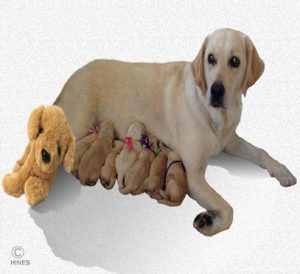The Stages of Canine Labor – When Your Dog Is About To Give Birth
Ron Hines DVM PhD
 Breeding & Care Of Your Pregnant Dog
Breeding & Care Of Your Pregnant Dog
Try not to worry – over ninety-eight percent of all dogs deliver their puppies without assistance or complications. But when it is your pet that is set to deliver puppies, it is comforting to know that things are proceeding without hitches and on schedule. But you are less apt to worry when you know the stages of canine labor – when your dog is about to give birth.
Midwifery:
After five to six weeks of pregnancy the mother’s appetite should gradually begin to increase. By late pregnancy, she will probably be consuming ~30-50% more food than she used to, depending on the number of puppies within her. When the puppies come, and she is producing milk, her food consumption should also be considerably more than it was before her pregnancy. Make those extra meals for her – rather than larger meals. If you purchase a name brand puppy diet to feed her with during this periods, there is no need to give her supplements of any kind. There is no need to restrict the mother’s normal exercise, but intensive exercise or work training should be curtailed. It is not desirable that your dog becomes fat.
Around the forty-fifth day, bring the pet in to be examined by your veterinarian. At this time, the vet will be able to palpate the puppies and give you an indication of how many to expect. If you need to know earlier, then have an ultrasound examination performed about the twenty-fifth day. Blood progesterone levels can be tested to confirm pregnancy at about day 34, but this test is rarely performed.
Here Are The Things That Should Happen As Your Dog Begins To Deliver Her Puppies:
Just Before Labor Begins:
Pregnancy in dogs last approximately 63 days (56-69 days). Toy breeds often deliver their puppies a week or so earlier; while large breeds tend to deliver later. Two weeks before your dog’s due date, begin to take its temperature at noon. Purchase a rectal or oral thermometer – but use it rectally. I have no experience using ear thermometers to gauge eminent delivery. I still find glass spirit rectal thermometers in 2018 and buy them by the dozen (stay away from those that contain mercury). Battery operated thermometers are fine too. You can lubricate these thermometers with margarine or KY jelly and insert them about an inch up your dog’s rear. These thermometers are not accurate if their tips are not substantially in the body. Leave it in place for three minutes. Your dog’s core temperature should be between 101 and 102.4 F/ 38.3-39.1 C. When your pet’s temperature drops below 100 F/ 37.8 C she should deliver her pups in less than twenty-four hours.
 Stage One of Labor:
Stage One of Labor:
During the first stage of labor, the cervix begins to dilate and uterine contractions begin. These contractions are painful and perplexing to a dog. She will probably appear quite uncomfortable and restless – pacing, shivering and panting. She most likely will not eat, and she may even vomit. Some dogs whine persistently. Others occupy themselves building a nest. Uterine contractions, although occurring, are not as easy to see as in humans. This is the longest stage of dog labor. It generally lasts six to eighteen hours. By the end of this period the dog’s cervix will have completely dilated for the puppies to pass. During this period keep the mother’s environment quiet and calm. I usually shut them off in a semi-darkened area such as a bathroom. Utility rooms often have a lot of cleaning supplies and other undesirable stuff a dog could get into.
 Stage Two of Labor:
Stage Two of Labor:
During the second stage of labor, your dog’s uterine contractions will begin in force. As this stage progresses, the placental water sacs break and a straw-colored fluid is passed. Each puppy has its own placenta and amniotic sac. They are expelled one-by-one after each puppy or sporadically during labor. Pups usually appear every half-hour or so after ten to thirty minutes of forceful straining. As the pups deliver, the mother will lick the puppy clean and bite off its umbilical cord. It is important to let the mother do this, if she will. Through this activity, hormones (at least one, prolactin) are released that help her bond with her puppies, recognize them as her own and produce milk. (read here) The rough licking by the mother also stimulates the puppies to breathe and improves their circulation. The mother will probably eat some of the afterbirths. If the mother does not clear the pup’s face, tear away the amniotic sacs and lick the pups to stimulate respiration, you need to do it. Tear the sacs open, clear all fluid away from the pup’s nose and mouth, and vigorously rub the puppy in a towel to stimulate its breathing. If that is not sufficient, I cover the tip of the pup’s face (mouth & nose) with my mouth, extend its neck and gently puff air to inflate its lungs. Too forcefully puffing can injure a puppy’s lungs. Don’t give up too soon. Some start to breathe even after 10 minutes.
It is not uncommon for the mother to take rests during labor and sometimes up to four hours pass between some puppies. If more than four hours have passed without a puppy, and you are certain more puppies are present, take your dog to a veterinary hospital. Also seek assistance if the mother strains forcefully for over an hour without producing another pup. If you see the rear legs of a puppy protruding from the dog’s vagina you can assist the mother by gently pulling the puppy in a downward and rearward arcing motion. You must do this, do it very gently because puppies are fragile and their body and tissues easily injured. It is normal for many puppies to be born rear feet first or breach. When a mother dog is stuck in an incomplete labor, the first thing veterinarians often do is administer oxytocin and calcium to stimulate uterine contractions. If the puppies are too big to pass through the birth canal or the oxytocin fails to induce successful labor, a cesarean section is indicated.
 Stage Three of Labor:
Stage Three of Labor:
The concept of a third stage of labor is borrowed from human labor terms. It is a very indistinct period in dogs. Once all the puppies have been born the dog enters this third stage of labor during which time the uterus contracts to near its original size, expelling any remaining placenta, blood and fluid.
Serious Problems That On Occasion Occur:
If the mother dog fails to go into labor within twenty-four hours after her body temperature dropped to below 100 F/ 37.8 C you should take her to your veterinarian. Also take her in if you have calculated that more than 69 days have passed since the dog was bred. Take her in if she shows any disturbing physical or psychological changes in her demeanor. Take her in if she runs a fever, pants, has difficulty urinating or shows lack of appetite. Begin by explaining the situation on the phone to your veterinarian’s technicians (not the receptionist). Some situations may not warrant the worry that first time pregnant dog owners experience. Some veterinarians will let you Skype real-time videos of your dog.
Some dogs suffer milk failure or insufficient milk production before their puppies are weaned. This occurs most often in older dogs as well as dogs that have another concurrent health problem such as eclampsia, mastitis or systemic disease. These dogs need to be taken directly to your veterinarian. Often those puppies will need supplemental nutrition from you or must be raised by hand. Read about that through the link at the top of this page or here
Signs that the mother’s milk supply is inadequate are thin or lean puppies that cry consistently, suck objects around them (or each other) and do not sleep.
It is not unusual for mother dogs to run a low fever during the first one or two days after giving birth. I become concerned if the fever is over 102.4 F (39 C), if the dog is drinking excessive water, if she is not eating or if she appears depressed. These may all be signs of a retained placenta (or puppy) or a uterine infection.
It is normal for a dog to have a rust-colored to greenish brown vaginal discharge following delivery. I become concerned when the discharge persists more than 3 days, is pus-like in consistency, has a strong odor or when it is accompanied by significant fever or panting. This can be a sign of retained placentas and uterine infection (metritis). In some dogs, a small amount of odorless discharge continues longer. The safest thing for you to do when concerned is to bring these dogs to your veterinarian and seek his/her opinion. Through palpation of your pet’s abdomen for abnormal firmness, lumps or sensitivity in the uterine region as well as other indications of metritis your veterinarian might determine the need for specific treatment. In those instances, it is often safest to hand-raise the puppies.
Normal mother dogs are bright, alert and attentive to their puppies. She should have a ravenous appetite as she converts food nutrients into milk. I become concerned if the mother shows any signs of listlessness or depression. She also needs to visit a veterinarian if she is not attentive to her puppies.
Check the mother’s milk flow. It should flow with only the slightest of finger pressure.
Eclampsia or Milk Fever:
Eclampsia is actually a glandular problem in which the dog’s parathyroid gland does not secrete sufficient calcium-releasing hormone (PTH). That causes her blood calcium level to become abnormally low. There is plenty of calcium in her body – she just cannot release it from her bones. It occurs most commonly during peak milk production but occasionally even before that. Signs of eclampsia include trembling, general weakness, a reluctance to get up or walk, confusion restlessness and apprehension. When severe, it can progress to rigidity, muscle spasms and seizures.
Milk fever is a very serious condition. It is most common in small breeds with large litters but can affect any mother dog. They often lose attentiveness to their puppies. The mother may run a fever and have a rapid heart rate. Relief is almost immediate (within 15 minutes) when your veterinarian slowly administers intravenous calcium. Other medications to relax muscle tone might be given as well. After a bout of milk fever, it is best to wean the puppies as quickly as possible or feed them supplemental milk formula. (read here) An oral calcium supplement for the mom might be helpful at this stage as well; but giving it before the problem arises does not seem to be helpful.
Mastitis or Breast Infection:
The normal breasts of mother dogs are soft, warm and enlarged. Although the breasts differ in size, they should be the same in texture and color. They should never be red, hot, painful or hard. Hard painful breasts are often signs of an infection. Dogs with mastitis are reluctant to let their puppies nurse and when they do allow it, usually little milk is produced. What is produced may be off in color and consistency. Hot packs on the affected breasts can help draw down the infection and, with antibiotics, usually solve the immediate problem. But the best solution for all is to feed the puppies yourself and let her (breasts) dry up.
Hypoglycemia or Low Blood Sugar:
This condition is easily confused with eclampsia. It is primarily a problem in toy and small breeds. The signs are disorientation, weakness, subnormal body temperature and a low blood sugar level. Dextrose solution, slowly administered intravenously by your veterinarian, solves the immediate problem. Longer term, feed the dog smaller, high-protein meals more frequently. Carbohydrate and sugar snacks give short blood sugar spikes. Proteins, converted into glycogen by your dog’s liver, furnish more stable blood glucose levels.
You are on the Vetspace animal health website
Visiting the products that you see displayed on this website help pay the cost of keeping these articles on the Internet.

